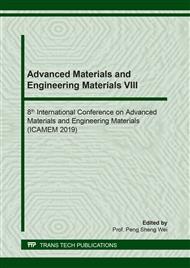[1]
K. Raghu, Y. Naidoo, Y. H. Dewir, Secretory structures in the leaves of Hibiscus sabdariffa L., South African Journal of Botany, 121 (2019) 16-25.
DOI: 10.1016/j.sajb.2018.08.018
Google Scholar
[2]
Ghazala Riaz, Rajni Chopra, A review on phytochemistry and therapeutic uses of Hibiscus sabdariffa L., Biomedicine & Pharmacotherapy,102 (2018) 575-586.
DOI: 10.1016/j.biopha.2018.03.023
Google Scholar
[3]
Siriphan Sukkhaeng, Somnuk Promdang, Uthaiwan Doung-ngern, Fruit characters and physico-chemical properties of roselle (Hibiscus sabdariffa L.) in Thailand—A screening of 13 new genotypes, Journal of Applied Research on Medicinal and Aromatic Plants, 11(2018) 47-53.
DOI: 10.1016/j.jarmap.2018.10.001
Google Scholar
[4]
Inês Da-Costa-Rocha, Bernd Bonnlaender, Hartwig Sievers, Ivo Pischel, Michael Heinrich, Hibiscus sabdariffa L. – A phytochemical and pharmacological review, Food Chemistry, 165 (2014) 424-443.
DOI: 10.1016/j.foodchem.2014.05.002
Google Scholar
[5]
Maria Antónia Nunes, Francisca Rodrigues, Rita C. Alves, Maria Beatriz P. P. Oliveira, Herbal products containing Hibiscus sabdariffa L., Crataegus spp., and Panax spp.: Labeling and safety concerns, Food Research International 100 (2017) 529-540.
DOI: 10.1016/j.foodres.2017.07.031
Google Scholar
[6]
Emad Mohamed Abdallah, Antibacterial activity of Hibiscus sabdariffa L. calyces against hospital isolates of multidrug resistant Acinetobacter baumannii, Journal of Acute Disease, 5 2016 512-516.
DOI: 10.1016/j.joad.2016.08.024
Google Scholar
[7]
Raheem Mohssin Shadhan, Siti Pauliena Mohd Bohari, Effects of Hibiscus sabdariffa Linn. fruit extracts on α-glucosidase enzyme, glucose diffusion and wound healing activities, Asian Pacific Journal of Tropical Biomedicine, 7 (2017) 466-472.
DOI: 10.1016/j.apjtb.2017.01.023
Google Scholar
[8]
Heba A. Sindi, Lisa J. Marshall, Michael R. A. Morgan, Comparative chemical and biochemical analysis of extracts of Hibiscus sabdariffa, Food Chemistry, 164 (2014) 23-29.
DOI: 10.1016/j.foodchem.2014.04.097
Google Scholar
[9]
Pi-Jen Tsai, John McIntosh, Philip Pearce, Blake Camden, Brian R Jordan, Anthocyanin and antioxidant capacity in Roselle (Hibiscus Sabdariffa L.) extract, Food Research International, 35 (2002) 351-356.
DOI: 10.1016/s0963-9969(01)00129-6
Google Scholar
[10]
Soledad Guardiola, Núria Mach, Therapeutic potential of Hibiscus sabdariffa: A review of the scientific evidence, Endocrinología y Nutrición (English Edition), 61 274-295.
DOI: 10.1016/j.endoen.2014.04.003
Google Scholar
[11]
V. L. Singleton, R. Orthofer, and R. M. Lamuela-Raventós, Analysis of total phenols and other oxidation substrates and antioxidants by means of folin-ciocalteu reagent,, in Methods in enzymology, 299 (1999) 152–178.
DOI: 10.1016/s0076-6879(99)99017-1
Google Scholar
[12]
Y. Gong, Z. Hou, Y. Gao, Y. Xue, X. Liu, and G. Liu, Optimization of extraction parameters of bioactive components from defatted marigold (Tagetes erecta L.) residue using response surface methodology,, Food Bioprod. Process., 91 (2012) 9–16.
DOI: 10.1016/j.fbp.2010.12.004
Google Scholar
[13]
I. F. Strati and V. Oreopoulou, Effect of extraction parameters on the carotenoid recovery from tomato waste,, Int. J. food Sci. Technol., 46 (2011) 23–29.
DOI: 10.1111/j.1365-2621.2010.02496.x
Google Scholar
[14]
N. E. Durling et al., Extraction of phenolics and essential oil from dried sage (Salvia officinalis) using ethanol–water mixtures,, Food Chem.,101(2007) 1417–1424.
DOI: 10.1016/j.foodchem.2006.03.050
Google Scholar
[15]
E. M. Silva, H. Rogez, and Y. Larondelle, Optimization of extraction of phenolics from Inga edulis leaves using response surface methodology,, Sep. Purif. Technol., 55 (2007) 381–387.
DOI: 10.1016/j.seppur.2007.01.008
Google Scholar
[16]
Z. Y. Ju and L. R. Howard, Effects of solvent and temperature on pressurized liquid extraction of anthocyanins and total phenolics from dried red grape skin,, J. Agric. Food Chem., 51 (2003) 5207–5213.
DOI: 10.1021/jf0302106
Google Scholar
[17]
J. Wang, B. Sun, Y. Cao, Y. Tian, and X. Li, Optimisation of ultrasound-assisted extraction of phenolic compounds from wheat bran,, Food Chem., 106 (2008) 804–810.
DOI: 10.1016/j.foodchem.2007.06.062
Google Scholar
[18]
M.-N. Maillard, M.-H. Soum, P. Boivin, and C. Berset, Antioxidant activity of barley and malt: relationship with phenolic content,, LWT-Food Sci. Technol., 29, (1996) 238–244.
DOI: 10.1006/fstl.1996.0035
Google Scholar
[19]
L. S. Kassama, J. Shi, and G. S. Mittal, Optimization of supercritical fluid extraction of lycopene from tomato skin with central composite rotatable design model,, Sep. Purif. Technol., 60 (2008) 278–284.
DOI: 10.1016/j.seppur.2007.09.005
Google Scholar
[20]
J. Xie, M. Xie, M. Shen, S. Nie, C. Li, and Y. Wang, Optimisation of microwave‐assisted extraction of polysaccharides from Cyclocarya paliurus (Batal.) Iljinskaja using response surface methodology,, J. Sci. Food Agric., 90 (2010) 1353–1360.
DOI: 10.1002/jsfa.3935
Google Scholar
[21]
M. Naczk and F. Shahidi, Extraction and analysis of phenolics in food,, J. Chromatogr. A, 105 (2004) 95–111.
Google Scholar
[22]
Y. Y. Thoo, S. K. Ho, J. Y. Liang, C. W. Ho, and C. P. Tan, Effects of binary solvent extraction system, extraction time and extraction temperature on phenolic antioxidants and antioxidant capacity from mengkudu (Morinda citrifolia),, Food Chem., 120 (2010) 290–295.
DOI: 10.1016/j.foodchem.2009.09.064
Google Scholar
[23]
P.-J. Tsai, J. McIntosh, P. Pearce, B. Camden, and B. R. Jordan, Anthocyanin and antioxidant capacity in Roselle (Hibiscus sabdariffa L.) extract,, Food Res. Int 35 (2002) 351–356.
DOI: 10.1016/s0963-9969(01)00129-6
Google Scholar
[24]
C. Liyana-Pathirana and F. Shahidi, Optimization of extraction of phenolic compounds from wheat using response surface methodology,, Food Chem., 93 (2005) 47–56.
DOI: 10.1016/j.foodchem.2004.08.050
Google Scholar
[25]
J. Zhou et al., Optimization of ultrasonic-assisted extraction and radical-scavenging capacity of phenols and flavonoids from Clerodendrum cyrtophyllum Turcz leaves,, PLoS One, 8 (2013).
DOI: 10.1371/journal.pone.0068392
Google Scholar
[26]
M. Vinatoru, An overview of the ultrasonically assisted extraction of bioactive principles from herbs,, Ultrason. Sonochem., 8 (2001) 303–313.
DOI: 10.1016/s1350-4177(01)00071-2
Google Scholar
[27]
D. D. Gertenbach, Solid-liquid extraction technologies for manufacturing nutraceuticals,, Funct. foods Biochem. Process. Asp., 2 (2002) 331–366.
Google Scholar
[28]
P. R. Gogate, Cavitational reactors for process intensification of chemical processing applications: A critical review,, Chem. Eng. Process.45 (2008) 515–527.
DOI: 10.1016/j.cep.2007.09.014
Google Scholar
[29]
V. M. Kulkarni and V. K. Rathod, A novel method to augment extraction of mangiferin by application of microwave on three phase partitioning,, Biotechnol. Reports, 6 (2015).
DOI: 10.1016/j.btre.2014.12.009
Google Scholar


